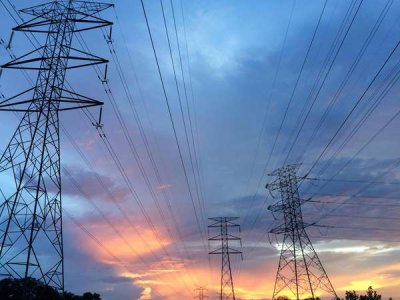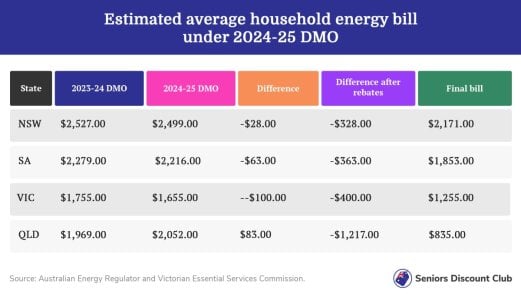Australian Energy Regulator announces power bill change in several Australia states
By
Danielle F.
- Replies 51
As the cost of living continues to be a pressing concern for many Australians, forms of financial relief are always welcome—may it be discounts, deals, or price cuts.
A recent announcement from the Australian Energy Regulator (AER) is a breath of fresh air—especially for those in Australia’s southeast states.
Starting from July 1, households across Australia's southeastern states can expect a significant reduction in their power bills, thanks to a cut in electricity price caps and the introduction of government energy rebates.
The AER's final default market offer (DMO)—a price ceiling to protect consumers from overpaying—has been revised, which resulted in lowered maximum charges that electricity retailers can impose on households.
In New South Wales, the cap will be reduced by up to $28, bringing the maximum amount down to $2499. Meanwhile in South Australia, the reduction is even more substantial at $63, with a new cap of $2216.
These figures don't factor in yet the household electricity rebate announced in the federal budget—meaning bills will be further reduced by an additional $300.
This is a significant saving that will undoubtedly help ease the financial burden for many.
Despite an increase in the default offer by up to $83 to $2052 for the next financial year, southeastern Queensland residents will not feel the pinch thanks to the federal government's rebate—coupled with a generous $1000 subsidy from the Labor state government.
Meanwhile, Victorians will enjoy a price fall of up to 5.7 per cent—$100 to $1655 before the $300 rebate is applied.
It's important to note that while only between eight and 12 per cent of households are signed up to the default market offer—almost 500,000 customers in total—the impact of the DMO extends beyond these figures.
Major retailers like Origin Energy and AGL use the state-specific caps as a benchmark for setting prices for the rest of their customers.
These benchmarks can start a ripple effect that will be felt across the market.
The rationale behind the reduction in the DMO is attributed to an easing in wholesale prices—the cost at which retailers purchase electricity before selling it to consumers.
However, this has been balanced with a rise in network costs, covering the maintenance of poles and wires infrastructure.
Despite this, the AER managed to keep customer prices from increasing by reducing the allowable margins for power companies.
While the moderation in default prices is a welcome development, Ben Barnes, Acting Chief Executive of the Australian Energy Council, cautioned that it could reduce competition in the sector and potentially limit retailers’s ability to offer discounts.
The future setting of the DMO will be crucial for maintaining industry confidence and enabling retailers to provide cheaper market offers.
With these changes in mind, AER Chair Clare Savage encouraged consumers to actively seek out better electricity deals.
'Most retailers have cheaper deals than the standing offer, so shopping around remains the best way to get the best price,' she advised.
Energy Minister Chris Bowen welcomed the AER's final offer and highlighted the government's investments in energy as instrumental in lowering household bills.
'Today's figures show a welcome downward trend for prices, but we know there's more to do—which is why we're delivering our reliable renewables plan and providing direct energy relief for every household energy bill,' he stated.
As we navigate the challenges of rising household expenses, these reductions offer a much-needed reprieve.
It's a reminder of the importance of staying informed about changes in the energy market and taking advantage of rebates and subsidies when they become available.
After all, a penny saved is a penny earned, and in this case, the savings could be substantial.

Have you experienced a reduction in your power bills recently, or do you have tips for fellow seniors on how to manage energy costs? Share your thoughts and advice in the comments below.
A recent announcement from the Australian Energy Regulator (AER) is a breath of fresh air—especially for those in Australia’s southeast states.
Starting from July 1, households across Australia's southeastern states can expect a significant reduction in their power bills, thanks to a cut in electricity price caps and the introduction of government energy rebates.
The AER's final default market offer (DMO)—a price ceiling to protect consumers from overpaying—has been revised, which resulted in lowered maximum charges that electricity retailers can impose on households.
In New South Wales, the cap will be reduced by up to $28, bringing the maximum amount down to $2499. Meanwhile in South Australia, the reduction is even more substantial at $63, with a new cap of $2216.
These figures don't factor in yet the household electricity rebate announced in the federal budget—meaning bills will be further reduced by an additional $300.
This is a significant saving that will undoubtedly help ease the financial burden for many.
Despite an increase in the default offer by up to $83 to $2052 for the next financial year, southeastern Queensland residents will not feel the pinch thanks to the federal government's rebate—coupled with a generous $1000 subsidy from the Labor state government.
Meanwhile, Victorians will enjoy a price fall of up to 5.7 per cent—$100 to $1655 before the $300 rebate is applied.
It's important to note that while only between eight and 12 per cent of households are signed up to the default market offer—almost 500,000 customers in total—the impact of the DMO extends beyond these figures.
Major retailers like Origin Energy and AGL use the state-specific caps as a benchmark for setting prices for the rest of their customers.
These benchmarks can start a ripple effect that will be felt across the market.
The rationale behind the reduction in the DMO is attributed to an easing in wholesale prices—the cost at which retailers purchase electricity before selling it to consumers.
However, this has been balanced with a rise in network costs, covering the maintenance of poles and wires infrastructure.
Despite this, the AER managed to keep customer prices from increasing by reducing the allowable margins for power companies.
While the moderation in default prices is a welcome development, Ben Barnes, Acting Chief Executive of the Australian Energy Council, cautioned that it could reduce competition in the sector and potentially limit retailers’s ability to offer discounts.
The future setting of the DMO will be crucial for maintaining industry confidence and enabling retailers to provide cheaper market offers.
With these changes in mind, AER Chair Clare Savage encouraged consumers to actively seek out better electricity deals.
'Most retailers have cheaper deals than the standing offer, so shopping around remains the best way to get the best price,' she advised.
Energy Minister Chris Bowen welcomed the AER's final offer and highlighted the government's investments in energy as instrumental in lowering household bills.
'Today's figures show a welcome downward trend for prices, but we know there's more to do—which is why we're delivering our reliable renewables plan and providing direct energy relief for every household energy bill,' he stated.
As we navigate the challenges of rising household expenses, these reductions offer a much-needed reprieve.
It's a reminder of the importance of staying informed about changes in the energy market and taking advantage of rebates and subsidies when they become available.
After all, a penny saved is a penny earned, and in this case, the savings could be substantial.
Key Takeaways
- The Australian Energy Regulator announced lower price caps to reduce power bills in Australia's southeastern states starting July 1.
- Households in NSW, South Australia, and Victoria will see their electricity bills decrease due to these lower price caps and government rebates.
- The default market offer will also affect more households as it serves as a benchmark for major retailers to set prices for their customers.
- Despite cost reductions in the default market offer, the energy industry warned that it could reduce competition and limit retailers' ability to offer discounts.









